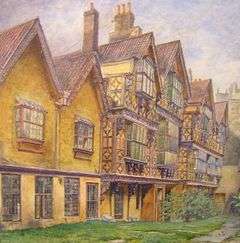Bristol Corporation of the Poor
 Watercolour of St Peter's Hospital, Bristol, former headquarters of the Bristol Corporation of the Poor, 1894 | |
| Motto | Hyemes memores estate laborant![1] |
|---|---|
| Formation | May 19, 1696 |
| Extinction | 17 October 1836 |
| Type | Charitable organisation |
| Purpose | Poor relief |
| Headquarters | St Peters Hospital, Bristol |
The Bristol Corporation of the Poor was the board responsible for poor relief in Bristol, England when the Poor Law system was in operation. It was established in 1696 by the Bristol Poor Act.[2][3] The main promoter of the act was a merchant, John Cary, who proposed "That a spacious workhouse be erected in some vacant place, within the city, on a general charge, large enough for the Poor, who are to be employed therein; and also with room for such, who, being unable to work, are to be relieved by charity."[4]
Upon establishment of the corporation the city aldermen chose four of the "honestest and discreetest inhabitants" from each of the twelve city wards to serve as "Guardians of the Poor".[1] This caused some resentment amongst the city churchwardens who had previously administered poor law funds and who withheld funds raised from the general rates.[5] The corporation raised funds by donation and established the first workhouse at a building called Whitehall, adjacent to the Bridewell.[6]
In 1698, the Corporation bought the former home of merchant Robert Aldworth who had left £1,000 in his will for the establishment of a workhouse. This building became known as St Peters Hospital,[2] and stayed in use until the 1830s. It was destroyed in the blitz during World War II.[7]
By 1826, the Corporation had acquired by donation a large number or properties and estates, bringing in a considerable income.[8] In 1836, following the passage of the Municipal Corporations Act 1835, Bristol Corporation of the Poor along with other municipal charities was transferred to the Bristol Charity Trustees, which later became Bristol Municipal Charities. This enabled them to buy the site of the defunct prison in Stapleton, hence founding Blackberry Hill Hospital.[9]
Archives
The majority of the records of the Bristol Poor Law Union were destroyed during the Bristol Blitz; however, Bristol Archives holds the surviving archives of Stapleton Workhouse and Clifton Workhouse (Ref. 30105) (online catalogue).
References
- 1 2 Johnson, 9-10
- 1 2 Manco, Jean (1 October 2006). "History of St Peter's Hospital, Bristol". Bristol Past. Retrieved 2009-07-18.
- ↑ Alistair Hudson, ed. (2003). New Perspectives on Property Law: Human Rights and the Family Home. Routledge-Cavendish. p. 291. ISBN 978-1-85941-843-7. Retrieved 2009-07-18.
- ↑ Johnson, 4
- ↑ Johnson, 12-14
- ↑ Johnson, 16-17
- ↑ "Bristol Workhouses". Rossbret Institutions Website. Retrieved 2009-07-18.
- ↑ Johnson, 82-90
- ↑ "History of Bristol Charities". Bristol Charities. Retrieved 2009-07-18.
Cited works
Johnson, James. Transactions of the Corporation of the Poor, in the City of Bristol, During a Period of 126 Years. Broadmead, Bristol. P. Rose. 1826
Further reading
Butcher, E.E., ed. Bristol Corporation of the Poor, 1696-1834. Bristol. Historical Association. ISBN 978-0-901388-07-0
